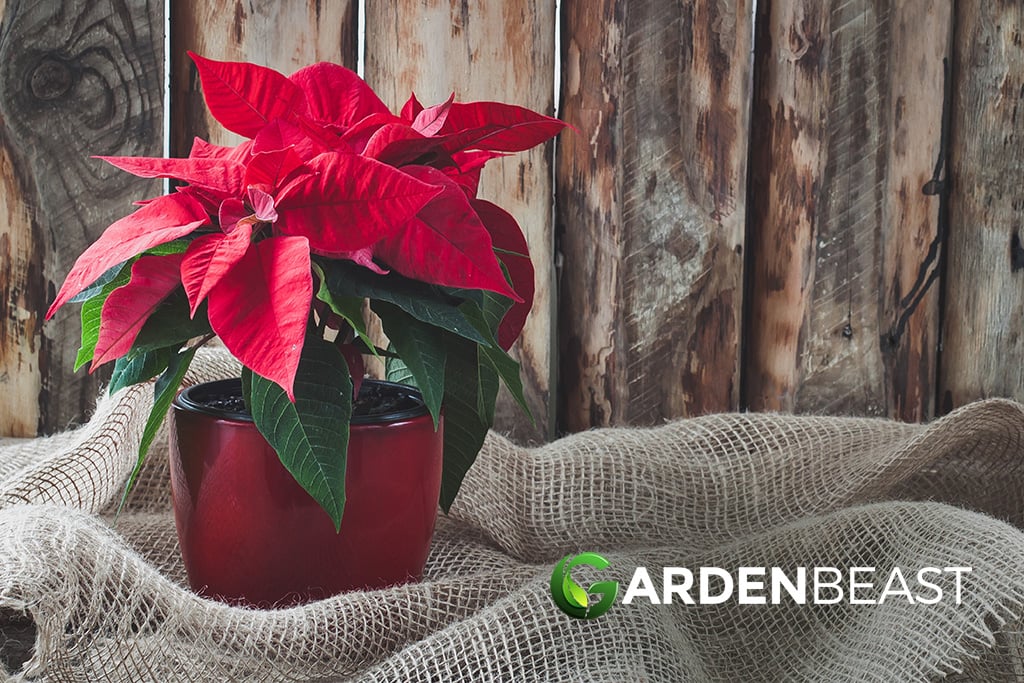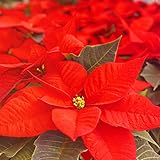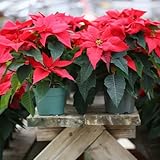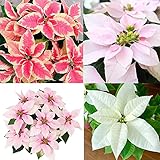Is it Christmas already? Either way, if you did not cross paths with these beauties already, now is the time. Especially if you are a gardener who likes a little challenge from time to time.
Euphorbia Pulcherrima, also known as Poinsettia, Christmas Flower, Winter Rose, Christmas Star, or Mexican Flame Leaf, is a species of perennial shrubs or small trees in the Euphorbiaceae family. Poinsettia plants are native to Central America regions, from southern Guatemala to Mexico.
The Christmas Flower’s association with the holiday started from a Mexican legend. The story is about a girl who was too poor to afford a proper gift for the celebration. She was inspired to go to the roadside and gather some weeds, then placed them at the church altar on Christmas Eve. As people watched, red and green bloomings have started to sprout from the weed, becoming what we are calling today a Poinsettia.
About Poinsettia
- Poinsettia is the most popular holiday houseplant, representing about one-quarter of the indoor plants sold in the United States.
- Their scientific name has Latin origins, meaning “the most beautiful Euphorbia”.
- Back in the day in Mexico, people have used Poinsettia to make purple dye for cosmetics and clothing.
- The Poinsettia plant is known as December’s birth flower.
- In Mexico, these plants play a huge role in the celebration of Christmas. The red color symbolizes the blood sacrifice of crucifixion, while their star-patterned foliage is considered a representation of the Star of Bethlehem.
- When Poinsettia plants are in full bloom, they prefer semi-cool temperatures and humid locations. Make sure you keep them away from heat sources and frost.
- From spring to fall, they love basking in full sunlight. During the winter, it is better to place them in a bright spot with indirect light.
- Protect your Poinsettia from pests using preventive insecticides and yellow sticky traps.
- Although there are rumors that Poinsettia plants are very toxic, studies have shown that they do not harm humans. However, you might consider protecting your curious pets from these plants, as their leaves can cause them digestive problems.
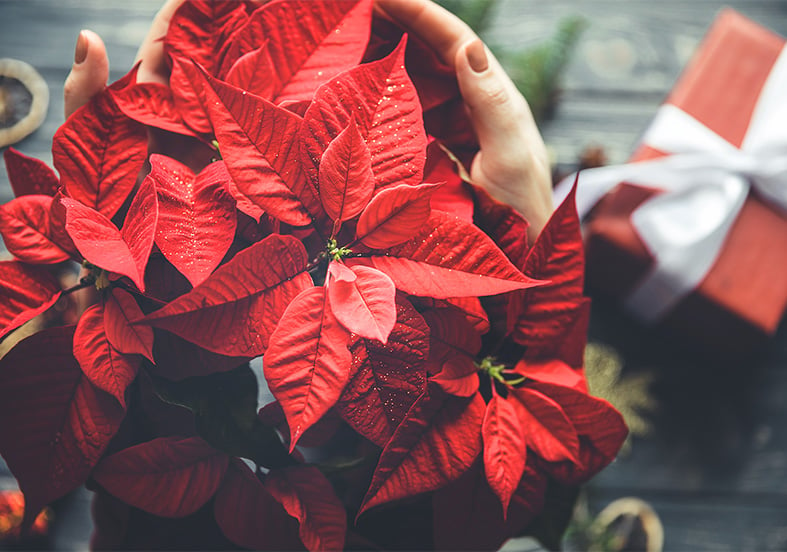
Poinsettia Features: An Overview
- Poinsettia plants can be found in tropical dry forests. Most wild species grow in steep canyons that are close to the Pacific Ocean.
- There are more than 100 varieties of Poinsettia plants available today. In their natural habitat, they can grow up to 15 feet (4.5 m) tall.
- Poinsettia plants produce a milky white sap called latex. In the past, this sap has been used in Mexico as a treatment for fevers.
- These plants have dark green leaves with dimensions between 2.8 and 6.3 inches (7-16 cm) in length.
- Their colored leaves are often mistaken for flowers due to their growth habit and vibrant colors. They are actually modified or specialized leaves known as “bracts”.
- Depending on the cultivars, the Christmasy red bracts can be replaced with a large variety of colors, such as pink, orange, cream, marbled, pale green, or white.
- Poinsettia plants need long periods of darkness to bloom and change their color.
- Due to their red foliage, Poinsettia plants are sometimes referred to as the Flame-leaf Flower or the Lobster Flower.
- The actual Poinsettia bloomings are small yellow structures that grow in the center of leaf bunches. They are considered false flowers and do not attract pollinators.
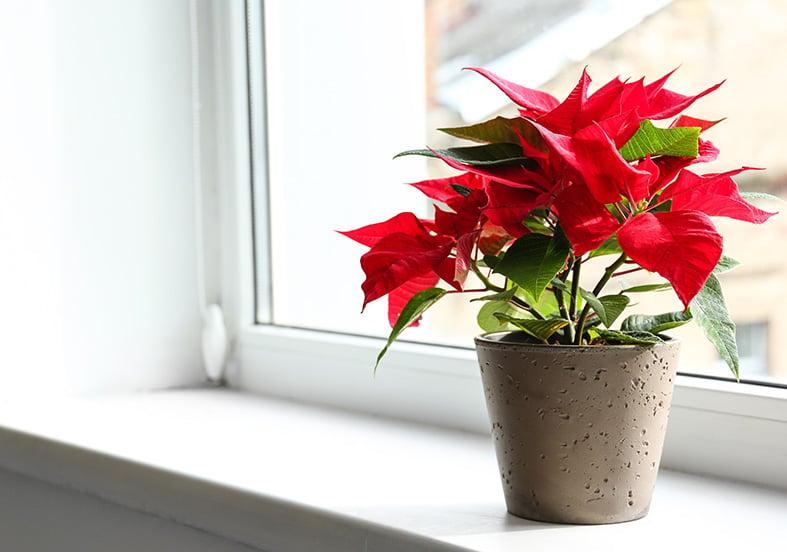
Growing Poinsettia
Sometimes, Poinsettia plants are quite hard to please. They bloom yearly in winter and require some extra attention to keep their flowers throughout the holidays. We know you are tempted to buy a new Poinsettia each Christmas, but with patience and proper care, these plants can grow happily in any household.
They are vigorous and healthy when they are exposed to full sun for a long period. If you provide them with plenty of light, they will exhibit the brightest foliage colors. You can place Poinsettia plants in any sunny location inside your home. Keep them away from north-facing windows, as they will not receive enough sunlight from that spot. During the winter, they prefer bright, but indirect light.
- TALL: Grows up to 3–10 ft. tall, 3–7 ft. wide.
- BLOOM PERIOD: Poinsettia blooms from winter through spring.
- SOW: In order to germinate, they first need to spend about three months in a cool place, like your refrigerator, a process called cold stratification.
- GERMINATION: In a short time, likely one to two weeks, your poinsettia seeds should germinate and the new seedlings begin to grow.
- TIPS: If your poinsettias are outside, they might be pollinated naturally by insects, but if you keep them as houseplants and will have to pollinate them yourself.
- Hardiness zone.9-11
- Grow.Sow your seeds, one per small pot, just below the soil surface in evenly moist potting soil. Keep in a warm area of subdued light (no direct sunlight!) and make sure the surface of the soil does not get too dry.
- Sun.Poinsettias need 10 weeks of 12 hours or less of sunlight each day to show color.
- Great.Poinsettias can stay attractive for months.
- Self-seeding.Grow from seed and enjoy growing with your family.
- USDA Hardiness Zone. Poinsettia is a very beautiful flowering shrub grown in 9-11(USDA).
- Poinsettia is fast growing and low-maintenance. Just provide enough filtered sun, warmth, and water, and your poinsettia will thrive.You can enjoy this beautiful plant for many years to come.
- Sow. Plant seeds under 1 ½ inches (4 cm.) of soil. Just keep the soil warm and moist until germination. Seedlings emerge in about a few weeks.
- Care. Provide enough filtered sun, warmth, and water, and your poinsettia will thrive. Frequent pinching back of the stem tips will ensure seasonal color in winter.
- Use. Poinsettia is a showy and spectacularly colorful perennial garden shrub. Its blooms are hugely attractive to bees, butterflies and hummingbirds. It is a good plant for containers, indoor plants, and as a hedge or an accent plant.
Last update on 2024-10-06 / Affiliate links / Images from Amazon Product Advertising API
You can grow these plants indoors throughout the summer without any problems. However, some gardeners choose to move their Poinsettia plants outdoors. You can put the plant’s container in the ground, in a bright location where your plant can is protected from direct sunlight. For optimal branching, you should trim off the stem tips once every month until August.
In the fall, it is better to bring the plant back indoors to protect it from cool temperatures. Provide the plant with long periods of darkness (minimum of 14 hours) every night to encourage blooming.
The biggest achievement with Poinsettia plants is to maintain their bloomings as long as possible. During the day, these plants do well in temperatures between 65 and 75 °F (18-23 °C) and will survive in temperatures that drop to 60 °F (15.5 °C) at night. Make sure you protect your Poinsettia from cold drafts and do not place it on a windowsill where its leaves can touch a cold window. This can damage them, resulting in premature leaf drop.

Poinsettia plants do well in loamy and well-draining soil. Look for potting soil with a pH between 5.5 and 6.5. The container in which you want to plant your Poinsettia should have a hole in the bottom, as it will improve drainage.
Starting from spring, Poinsettia plants will benefit from regular fertilizing. You can feed your plants with a complete houseplant fertilizer at half strength once every two or three weeks. During the blooming period, it is better to keep your plant away from fertilizers.
Repotting Poinsettia plants occasionally will keep them from becoming root-bound. The best time to repot your Poinsettia is in spring when it is about to develop new growth. Fill a pot that has drainage holes with fresh well-draining potting soil. The container should be about 2 inches (5 cm) larger than the current one. Make sure you cut all the unhealthy roots from your plant before replanting it and water it thoroughly.
Watering Poinsettia
Poinsettia plants love to be watered thoroughly, especially during the holidays. However, be careful not to over-water them, as this can quickly result in waterlogging and root rot. Avoid drowning or drying out the roots.
To keep these plants happy, you need to find the right balance of dryness and moisture. Make sure you always inspect the plant and the soil in-between waterings. If you notice some yellow or falling leaves, it may be a sign that you do not water your plant right.
Depending on the container size, the frequency of watering may vary. If your Poinsettia grows in a small pot, it will need watering more often than a Poinsettia planted in a larger one, as it will dry out faster. Generally, Poinsettia needs watering when the soil is noticeably dry. You can find out when it is time to water by lifting the container. If it feels light, your plant is thirsty.
During the blooming season, these plants prefer plenty of moisture. Use a humidifier or mist them regularly to maintain a humid environment. When the spring has settled in, it is enough to place your Poinsettia plant in a sunny spot and water it well.
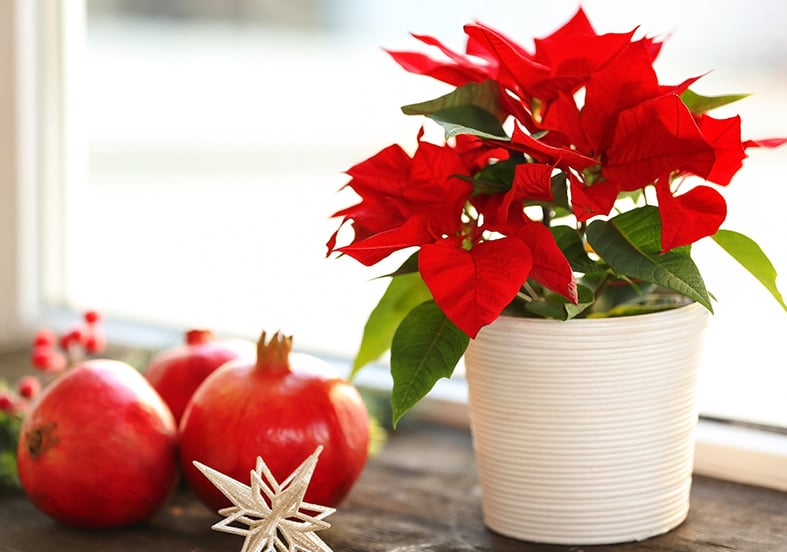
Propagating Poinsettia
Do you want to surprise your friends with a nice gift for the holidays? Say no more! You can show up at their door with cute baby Poinsettias, as propagating these plants is a piece of cake. The most efficient method to propagate a Poinsettia is by stem cuttings.
Make sure you use healthy stem cuttings, as older stems that flowered during the current winter are not recommended for propagation. Allow the new stems to grow at least 4 inches (10 cm) before you cut them.
Once the plant has produced useful cuttings, you should look for a stem that has two or three mature leaves. Cut a stem of 3 to 4 inches (7-10 cm) using a sharp knife and treat it with rooting hormone to boost the root development.
Fill a pot with well-draining potting soil and plant your cutting carefully. To maintain a humid environment and prevent the cutting from wilting, you need to put the container inside a closed plastic bag. The cutting can be placed in a greenhouse or on a windowsill.
If you provide them with plenty of bright light, your cuttings will develop a stable root system after 3 or 4 weeks. You can let your baby Poinsettia grow outdoors until fall. When temperatures start to drop, bring it inside and keep it in darkness for a long period, as this will induce blooming.
In Conclusion
We know it seems a bit difficult at first to grow and care for these Christmas plants. Do not be scared, as even the most experienced gardeners find them difficult to grow. To keep Poinsettias in bloom, make sure you give them bright and indirect light, a semi-cool and humid location, and regular watering. Once the temperatures start to rise, they become pretty easy to grow.
If you want to try something different, you can look for other varieties of Poinsettia, such as Tri-Color, Jingle Bells, Plum Pudding, Lemon Drop, or Prestige Maroon. They are gorgeous and can be a perfect gift for yourself or your friends during the holidays.
